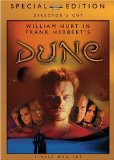Synopsis
Herbert’s novel is very complex, and one attempts a synopsis at one’s own risk (this is part of the problem with Lynch’s film). At its most basic, it is about power struggles in a galactic empire, power struggles centred on the planet Arrakis, or Dune, home of the spice, the most vital element in the empire. Paul Atreides, newly arrived on Arrakis, turns out to be the long-prophesied messiah. This is an incredibly ambitious project for a telefilm, and though some of the budgetary limitations…are visible (primarily in the obviously cost-conscious spartan look to the set design), the effort deserves kudos for going for the gusto.
Audio
While not overwhelming, the sound is very good by television standards. The music sounds great, and the sound effects have a solid surround presence. The left-right separation could be stronger. The voices, while distortion-free, could benefit from being boosted in the mix a touch more.
Video
The picture (in 1.77:1 anamorphic widescreen) is razor sharp, and the colours and contrasts are excellent. The picture is so sharp, in fact, that the lower-end CGI is more noticeable than it would be otherwise. There is also some visible edge enhancement. A very nice look overall, however.
Special Features
Quite a bit here, making this one of Artisan’s stronger recent releases. The menu is fully scored and animated, but there are no transitions. Each disc has its own set of features, except for the commentary (by John Harrison, Ernest Farino, Harry Miller, Greg Nicotero and Tim McHugh), which runs over all three (and has a lot to say about the challenges of adapting this book). Disc 1 has “The Lure of Spice”, a 25-minute behind-the-scenes documentary; “Graeme Revell Reveals” (an interview with the composer); and a photo and sketch gallery divided into Visual Effects, Storyboards, and Character and Costume Sketches. Disc 2 has Dune Encyclopedia author Willis NcNelly discussing the book and Frank Herbert; cast and crew bios; production notes; and “Science Future/Science Fiction” — a discussion by authors, scientists and filmmakers not about Dune as such, but about the role of science fiction in the real world. Disc 3 has “The Color Wheel” (a profile of DP Vittorio Storaro); an essay by Storaro called “The Cinematographic Ideation of Frank Herbert’s Dune”; “Defining the Messiah” (a documentary on exactly that, again not dealing directly with Dune); an interview with director John Harrison; preproduction costume sketches for Children of Dune; and trailers for the Rambo Trilogy and National Lampoon’s Van Wilder. There is a fair bit of overlap in all this, but a lot of ground is covered as well.
Closing Thoughts
The mini-series aims high, and the release has many nice features. A nice touch is that not all the features are about the film itself, but about ideas contained within the film.
Special Features List
- Audio Commentary
- “The Lure of Spice” Behind the Scenes
- “Graeme Revell Reveals” Profile
- Photo and Sketch Gallery
- Willis McNelly on Frank Herbert and Dune
- Cast and Crew Bios
- Production Notes
- Science Fiction/Science Future Roundtable
- “The Color Wheel” Profile
- “The Cinematographic Ideation of Frank Herbert
- “Defining the Messiah” Featurette
- John Harrison Interview
- Children of Dune Preproduction Sketches




